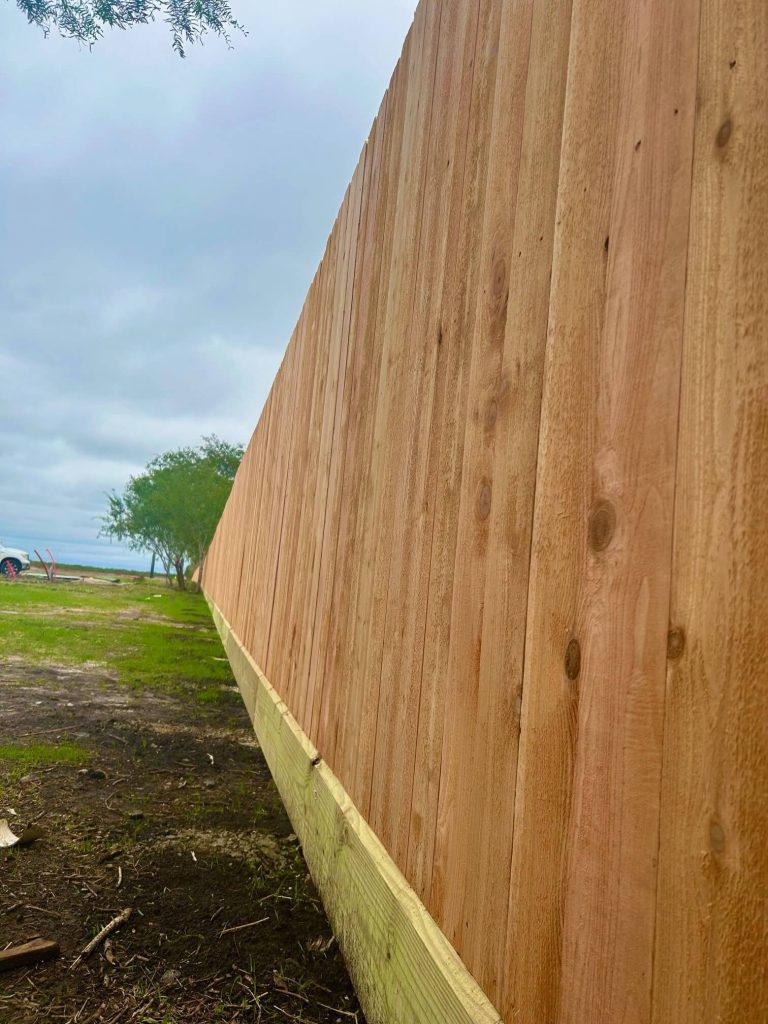Adding Home Value With a New Fence Installation
We’ve seen fences define boundaries, enhance privacy, and boost curb appeal. When it comes to adding home value, a new fence installation can be a smart investment. It’s not just about creating a physical barrier; it’s about crafting an inviting first impression and securing your property. While the right fence can notably increase your home’s worth, choosing the wrong type or style might have the opposite effect. As we explore the various aspects of fence installation and its impact on property value, you’ll discover how this seemingly simple addition can make a remarkable difference in your home’s market appeal.

Key Points
- A well-designed fence can yield a significant ROI of 50% to 70% on property value.
- Fences enhance curb appeal, creating positive first impressions for potential buyers.
- Privacy and security benefits from fencing contribute to increased property attractiveness and value.
- Selecting the right fence material based on durability, maintenance, and aesthetics maximizes long-term value.
- Consider neighborhood preferences, local regulations, and market trends when installing a fence to boost home value.
Types of Fences for Property Value
When examining fence installation to enhance property value, one must carefully assess the various options available. We’ll explore the most effective types of fences that can improve our home’s worth and curb appeal.
Wood and vinyl privacy fences are popular choices for their decent return on investment. These solid fencing options provide both security and aesthetic appeal, which are vital factors in property value enhancement. Vinyl fencing, in particular, dominates the residential market due to its low maintenance requirements, making it an appealing option for homeowners looking to increase their property’s value.
Additionally, chain link fences offer benefits such as security and low maintenance, although they mightn’t provide as high a return on investment as wood or vinyl options.
Cast iron fences, while more expensive, can potentially yield up to 50% of the installation cost upon resale. This makes them a valuable choice for those seeking a noteworthy boost in property value. However, it’s crucial to consider the aesthetic compatibility of the fence with our home’s style to maximize its impact.
While chain link fences are cost-effective, they offer a lower return on investment compared to solid fencing options. When aiming to increase property value, we should prioritize fences that provide privacy, security, and visual appeal. By choosing the right type of fence, we can greatly enhance our home’s overall value and marketability.
Cost Vs. Return on Investment
The balance sheet of fence installation reveals a nuanced picture when it comes to cost versus return on investment. We often find that adding a fence to our property can yield a significant ROI, typically ranging from 50% to 70%. For instance, a $10,000 investment in fencing might increase our home’s value by approximately $7,000.
While fences enhance curb appeal and property value, it’s important to understand that they may not fully recover their cost at resale. However, with careful planning and material selection, we can maximize our return.
We should remember that a well-designed, high-quality fence installation can potentially yield a 70% ROI. By focusing on both functionality and aesthetics, we can guarantee our fencing project contributes positively to our home’s overall value and appeal.
Curb Appeal and First Impressions
Beyond the financial considerations, we must recognize the noteworthy impact a fence has on a property’s curb appeal and first impressions. A well-designed fence installation can instantly transform the appearance of our homes, adding a touch of elegance and making them stand out positively in the real estate market. We’ve seen how various fencing options, including wood fences and wrought iron fences, contribute to the overall aesthetic appeal of a property.
Wood fences, particularly, bring warmth and charm, enhancing the natural beauty of any home.
When we’re adding value to our homes, we can’t overlook the power of property aesthetics. The right fence design notably influences visual appeal and creates a lasting first impression on potential buyers. We’ve noticed that popular choices like classic white picket fences or modern wrought iron fences can elevate the curb appeal of a home, making it more attractive and memorable.
As we consider fence installation, it’s important to remember that this addition does more than just define boundaries. It enhances our property’s overall look, creating a cohesive and inviting exterior. By carefully selecting a fence that complements our home’s architecture and neighborhood style, we’re not just improving security – we’re making a statement about our property’s value and appeal.
Privacy and Security Benefits
Privacy and security benefits stand out as compelling reasons for fence installation. We acknowledge that homeowners and potential buyers alike prioritize these aspects when considering a property. A well-constructed fence provides immediate privacy, creating a secluded haven for residents to enjoy their outdoor spaces without prying eyes. This enhanced privacy contributes significantly to the overall value and curb appeal of the home. Additionally, vinyl fencing offers durability and requires minimal maintenance, further increasing the property’s attractiveness.
Security is another vital factor that fence installation addresses. By establishing a physical barrier, fences deter potential intruders and provide peace of mind for occupants. This is particularly important for families with children and pets, as it offers a safe, enclosed area for outdoor activities.
Consider these additional benefits of fence installation:
- Reduces concerns during the moving process for parents with young children and pets
- Increases property appeal and value due to the added privacy and security
- Enhances the overall aesthetic of the property, complementing existing landscaping
- Provides a clear boundary demarcation, reducing potential disputes with neighbors
We acknowledge that privacy and security are essential needs for homeowners. By investing in fence installation, we not only address these needs but also contribute to the long-term value and desirability of the property.
Selecting the Right Fence Material
When considering fence materials, we’ll compare wood and vinyl options, as both offer distinct advantages for homeowners.
We’ll also examine the benefits of iron fences, which provide exceptional durability and aesthetic appeal.
Our analysis will include cost-benefit considerations to help you make an informed decision that balances initial investment with long-term value and maintenance requirements.
Wood Vs. Vinyl Options
Choosing between wood and vinyl fencing materials is a crucial decision when planning a new fence installation. We’ll explore the pros and cons of each option to help you make an informed choice that enhances your property’s curb appeal and meets your specific needs.
Wood fences offer a classic, natural look that can greatly enhance your property’s rustic charm. They’re highly customizable regarding design and texture, allowing for a unique aesthetic. However, wood fences require regular upkeep, including staining and sealing, to preserve their appearance and durability.
Vinyl fences, on the other hand, are known for their low-maintenance nature and durability. They’re resistant to rot, mold, and pests, making them a hassle-free choice for homeowners. Vinyl fences are easy to clean with just soap and water, saving you time and effort in the long term.
When choosing between wood and vinyl, consider these factors:
- Initial cost and long-term maintenance expenses
- Desired aesthetic and property style
- Climate and environmental conditions
- Local regulations and homeowners’ association rules
Ultimately, both wood and vinyl fences can add value to your home. Your decision should align with your property’s overall appearance, your maintenance preferences, and your budget.
Iron Fence Advantages
While wood and vinyl fences offer distinct advantages, iron fences present a compelling option for homeowners seeking durability and elegance. These fences add uncapped value to properties due to their exceptional longevity, often lasting for the lifetime of the home. We’ve found that iron fences enhance property value to a large extent, making them an excellent investment for those looking to boost their home’s worth.
Let’s compare some key aspects of iron fences:
| Feature | Benefit |
| Durability | Withstands harsh weather |
| Longevity | Lasts for decades |
| Added Value | Increases property worth |
| Security | Provides robust protection |
| Versatility | Customizable designs |
While iron fences may offer less privacy compared to wood options, their strength and durability make them an ideal choice for homeowners prioritizing security. We’ve found that adding wire mesh to iron fences can effectively contain small pets, addressing potential concerns about animal safety.
Iron fences’ enduring nature means they require minimal maintenance, saving homeowners time and money in the long run. Their elegant appearance and structural integrity make them a popular choice among those seeking to enhance their property’s aesthetic appeal while ensuring lasting value.
Cost-Benefit Analysis Considerations
How can homeowners determine the most cost-effective fencing option for their property? When considering installing a fence to increase property value and curb appeal, it’s essential to perform a thorough cost-benefit analysis. We’ll explore various fence materials and their potential return on investment.
Wood and vinyl privacy fences are popular choices, offering a decent return. Solid fencing options like cast iron can potentially yield up to 50% of the installation cost upon resale. Vinyl fencing dominates the residential market due to its low maintenance requirements, making it an appealing option for many homeowners.
When conducting a cost-benefit analysis, consider these factors:
- Initial installation costs
- Long-term maintenance expenses
- Potential increase in property value
- Aesthetic compatibility with the house’s style
To maximize the value added by a new fence, we must carefully evaluate the aesthetic compatibility of the chosen material with the overall style of the house. This consideration is essential for a successful sale and can greatly impact the fence’s contribution to the property’s value. By weighing these factors, we can make an informed decision that balances cost-effectiveness with long-term benefits.
Neighborhood and Market Considerations
Within the field of new fence installation, neighborhood and market considerations play a key role in decision-making. We must carefully evaluate how a fence impacts our property and its surroundings, as well as its potential to enhance our home’s curb appeal and selling price in the real estate market.
When considering a fence installation, we should assess the preferences of potential buyers in our area. Neighborhoods with pre-installed fences often attract more families with children and pets, which can be an important advantage if we’re looking to sell. A well-chosen fence provides immediate privacy and security, addressing potential concerns during the moving process and making our property more appealing to prospective buyers.
It’s essential that we select a fence material and style that complements our home’s architecture and aligns with neighborhood aesthetics. This compatibility can have a significant impact on the return on investment upon resale. By thoughtfully integrating a fence that enhances our property’s overall appeal, we’re not only improving our current living situation but also potentially increasing our home’s value in the long term.
Maintenance and Long-Term Value
When considering a new fence installation, we must recognize the pivotal role of maintenance in preserving long-term value.
Regular upkeep, including staining, repairs, and inspections, is essential for extending the fence’s lifespan and enhancing property appeal.
We’ll explore cost-effective strategies to protect your investment, ensuring your fence remains an asset rather than a liability.
Regular Upkeep Essentials
While the initial installation of a new fence is vital, regular upkeep is equally important for maintaining its integrity and value over time. We can’t emphasize enough how routine fence maintenance contributes to long-term value and curb appeal. By investing in regular upkeep, we’re not only preserving our property’s aesthetics but also safeguarding its value for potential buyers.
Let’s consider these necessary maintenance tasks:
- Cleaning to remove dirt, mold, and debris
- Staining or painting to protect against weather damage
- Inspecting for and repairing loose boards or posts
- Treating wood fences to prevent rot and insect infestation
These simple yet essential steps can significantly prolong our fence’s lifespan, preventing costly repairs or premature replacement.
We should also consider professional services for more complex maintenance needs. These experts can guarantee our fence remains structurally sound and visually appealing, which is particularly important when considering property value.
Cost-Effective Preservation Strategies
Building on our understanding of regular upkeep, let’s explore cost-effective strategies to preserve our fence’s value over time. When we install a new fence, we’re not just adding a boundary; we’re investing in our property’s curb appeal and long-term value. By implementing smart preservation strategies, we can ensure our fence continues to contribute positively to our home’s worth.
| Strategy | Benefit | Cost-Efficiency |
| Annual Staining | Protects wood | High |
| Prompt Repairs | Prevents deterioration | Medium |
| Weatherproofing | Extends lifespan | High |
| Regular Cleaning | Maintains appearance | Low |
| Professional Inspections | Identifies issues early | Medium |
These strategies are essential for Adding Home Value through Fence Installation. By consistently maintaining our fence, we’re preserving its aesthetic appeal and structural integrity. This attention to detail not only saves us money in the long run by avoiding costly replacements but also demonstrates pride of ownership. When it comes to selling, a well-maintained fence can greatly impact a potential buyer’s perception of our property’s overall value. By investing in these preservation techniques, we’re not just maintaining a fence; we’re nurturing an asset that contributes to our home’s appeal and market value.
Permitting and Legal Considerations
Before starting on a fence installation project, it’s important to navigate the maze of permitting and legal considerations. We must check local zoning laws and regulations to guarantee compliance with legal requirements. In many areas, obtaining a permit is necessary for fence installation to avoid future legal issues. Failure to adhere to these regulations can result in fines, penalties, or even having to remove the fence.
Legal considerations we need to be aware of include:
- Property line disputes
- Setback requirements
- Height restrictions
- Specific material or design regulations
To guarantee a smooth fence installation process, we should consult with local authorities or professionals who can guide us through these legal intricacies. They can help us understand the specific requirements for our area and provide valuable insights into potential challenges we might face.
Frequently Asked Questions
Does a New Fence Add Value to Your Home?
Yes, we can confidently say that a new fence adds value to our homes. We’re looking at up to a 10% increase in property value, plus enhanced appeal for buyers, especially families. It’s a smart investment for our homes.
What Type of Fence Adds the Most Value?
We’ve found that vinyl and wood privacy fences typically add the most value to homes. They offer a great return on investment, with vinyl leading in residential markets due to its low maintenance. Cast iron fences can also recoup significant costs.
What Is the Return on Investment for a Fence?
Let’s examine the ROI for fences. We’re looking at a range of 50% to 70%, typically. For example, a $10,000 fence might add $7,000 to our home’s value. It’s important we set realistic expectations, fellow homeowners.
Does a Chain Link Fence Decrease Property Value?
We’ve found that chain link fences typically don’t decrease property value, but they might not increase it either. They’re functional, but often less appealing to buyers. We’d recommend considering other fence types for better value enhancement.
The Takeaway
As we’ve explored, installing a new fence can be a smart investment for homeowners. But how do we maximize our property’s potential? We must carefully consider fence type, cost, aesthetics, and local regulations. By balancing these factors, we’re not just erecting a barrier; we’re enhancing security, privacy, and curb appeal. With proper planning and execution, a new fence can greatly boost our home’s value and market appeal for years to come.








